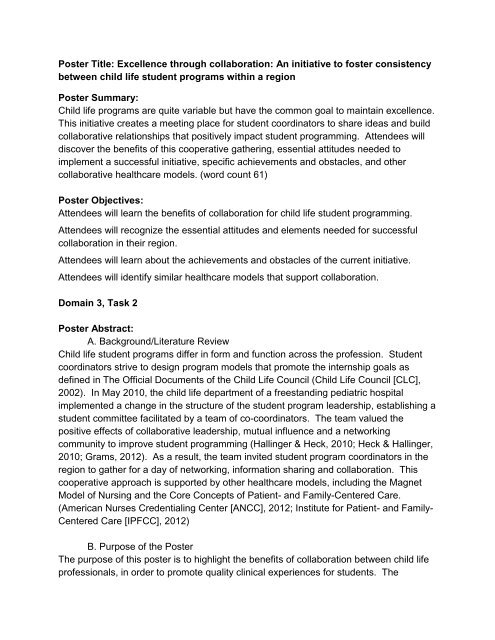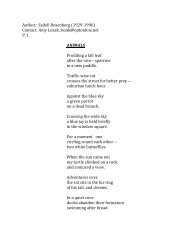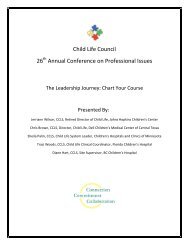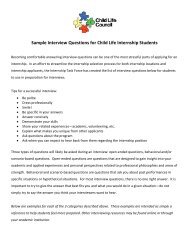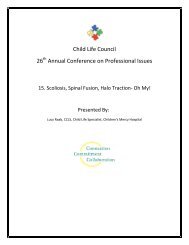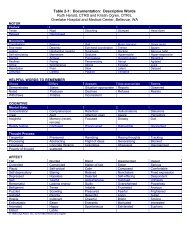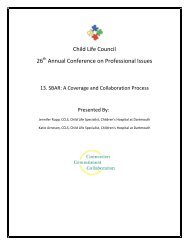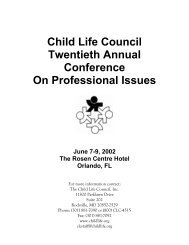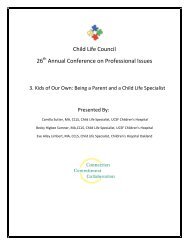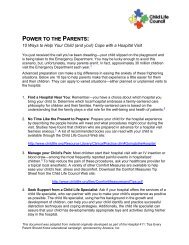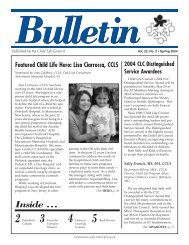Sample Abstract C - Child Life Council
Sample Abstract C - Child Life Council
Sample Abstract C - Child Life Council
Create successful ePaper yourself
Turn your PDF publications into a flip-book with our unique Google optimized e-Paper software.
Poster Title: Excellence through collaboration: An initiative to foster consistency<br />
between child life student programs within a region<br />
Poster Summary:<br />
<strong>Child</strong> life programs are quite variable but have the common goal to maintain excellence.<br />
This initiative creates a meeting place for student coordinators to share ideas and build<br />
collaborative relationships that positively impact student programming. Attendees will<br />
discover the benefits of this cooperative gathering, essential attitudes needed to<br />
implement a successful initiative, specific achievements and obstacles, and other<br />
collaborative healthcare models. (word count 61)<br />
Poster Objectives:<br />
Attendees will learn the benefits of collaboration for child life student programming.<br />
Attendees will recognize the essential attitudes and elements needed for successful<br />
collaboration in their region.<br />
Attendees will learn about the achievements and obstacles of the current initiative.<br />
Attendees will identify similar healthcare models that support collaboration.<br />
Domain 3, Task 2<br />
Poster <strong>Abstract</strong>:<br />
A. Background/Literature Review<br />
<strong>Child</strong> life student programs differ in form and function across the profession. Student<br />
coordinators strive to design program models that promote the internship goals as<br />
defined in The Official Documents of the <strong>Child</strong> <strong>Life</strong> <strong>Council</strong> (<strong>Child</strong> <strong>Life</strong> <strong>Council</strong> [CLC],<br />
2002). In May 2010, the child life department of a freestanding pediatric hospital<br />
implemented a change in the structure of the student program leadership, establishing a<br />
student committee facilitated by a team of co-coordinators. The team valued the<br />
positive effects of collaborative leadership, mutual influence and a networking<br />
community to improve student programming (Hallinger & Heck, 2010; Heck & Hallinger,<br />
2010; Grams, 2012). As a result, the team invited student program coordinators in the<br />
region to gather for a day of networking, information sharing and collaboration. This<br />
cooperative approach is supported by other healthcare models, including the Magnet<br />
Model of Nursing and the Core Concepts of Patient- and Family-Centered Care.<br />
(American Nurses Credentialing Center [ANCC], 2012; Institute for Patient- and Family-<br />
Centered Care [IPFCC], 2012)<br />
B. Purpose of the Poster<br />
The purpose of this poster is to highlight the benefits of collaboration between child life<br />
professionals, in order to promote quality clinical experiences for students. The
presentation will provide an overview of how a region of child life student coordinators<br />
created a networking initiative for the purposes of building positive working<br />
relationships, establishing lines of communication, supporting one another through<br />
program growth and challenges, and increasing consistency amid regional student<br />
programming.<br />
C. Program’s Development/Description of Concept/Methodology of Research-<br />
In May 2011, a children’s hospital hosted the first regional gathering of student<br />
coordinators representing eight child life programs. Since that meeting, there have<br />
been two other sessions hosted by other children’s hospitals in the region, with the<br />
fourth scheduled for the fall 2012. These full-day sessions allowed student coordinators<br />
the opportunity to openly discuss programming processes, needs and challenges. This<br />
encouraged community and prevented one organization from dominating the discussion<br />
(Grams, 2012), thus fostering an attitude of collaboration rather than competition. For<br />
example, discussion items were collectively decided prior to the gathering and<br />
prioritized by all attendees on the day of the session. In order to ensure productive<br />
dialogue, coordinators from the host-hospital facilitated conversation, served as<br />
timekeeper and transitioned the discussion. Topics discussed have included:<br />
• Implementation of CLC certification eligibility requirements relevant to student<br />
programming (CLC, 2012)<br />
• Alignment of practicum and internship expectations and program content<br />
• Implementation of effective supervisor training<br />
• Structure of departmental student programming team<br />
• Partnerships with regional academic institutions<br />
Coordinators at the host-hospital were responsible for delegating action-items requiring<br />
follow through and providing meeting minutes to both those present and those unable to<br />
attend.<br />
D. Results/Outcomes -<br />
As a result of this initiative, child life professionals in the region have built positive and<br />
supportive relationships. Attendees have reported they are more comfortable<br />
contacting each other with questions and concerns and agree that student programs<br />
benefit from these conversations. Other outcomes include document sharing and<br />
increased consistency between programs in the region. For example, at the most<br />
recent session, attendees agreed to follow common deadlines and offer dates for<br />
practicum programs. For the spring 2012 session, representatives from universities and<br />
colleges were invited to share their feedback and ideas, affording an opportunity to build<br />
relationships and improve communication between academic institutions and child life<br />
programs. Their participation has created an avenue for discussion around the <strong>Child</strong><br />
<strong>Life</strong> <strong>Council</strong>’s requirements for academic preparedness (CLC, 2012b). Obstacles
include event promotion and participation; however, the number of programs<br />
represented increased with each networking session.<br />
E. Relevance to child life practice<br />
This initiative impacts child life practice by creating a practical forum for relationship<br />
building and discussion between multiple organizations. Attendees are able to better<br />
their student program content in a way that is meaningful and supportive, thus directly<br />
benefitting students who complete training programs in the region. Through this<br />
initiative, student coordinators discuss and promote recent CLC efforts to bring<br />
consistency and credibility to training programs (CLC, 2012b). Just as the participants<br />
of this initiative embrace the components of collaborative leadership, innovation, and<br />
information sharing supported by the Magnet Model of Nursing (ANCC, 2012) and the<br />
Core Concepts of Patient- and Family-Centered Care (IPFCC, 2012), other regional<br />
child life professionals can collaborate to implement similar programs.<br />
Poster Organization:<br />
The poster will be composed of three sections. Section one will introduce the<br />
background information, the process of conducting a needs assessment, and<br />
developing and implementing a regional initiative. A model, highlighting the essential<br />
elements of the initiative and illustrating their relationship to one another, anchors<br />
section two, the largest section. Components of this model include collaborative<br />
leadership, mutual influence, innovation, information sharing, peer collaboration, and<br />
communication. Lastly, section three, will identify obstacles and clarify outcomes<br />
achieved by the initiative.<br />
References:<br />
American Nurses Credentialing Center. (2012). Magnet recognition program model.<br />
Retrieved from http://www.nursecredentialing.org/Magnet/ProgramOverview/New-<br />
Magnet-Model.aspx<br />
<strong>Child</strong> <strong>Life</strong> <strong>Council</strong>. (2002) Official documents of the <strong>Child</strong> <strong>Life</strong> <strong>Council</strong>. (3rd ed.).<br />
Rockville, MD: <strong>Child</strong> <strong>Life</strong> <strong>Council</strong>.<br />
<strong>Child</strong> <strong>Life</strong> <strong>Council</strong>. (2012a). Eligibility requirements. Retrieved from<br />
http://www.childlife.org/Certification/Getting20Certified/EligibilityRequirements.cfm<br />
<strong>Child</strong> <strong>Life</strong> <strong>Council</strong>. (2012b). <strong>Child</strong> life professional certification candidate manual.<br />
Retrieved from http://www.childlife.org/Certification/Getting20Certified/Eligibility<br />
Requirements.cfm
Grams, C. (2012, July) The innovative power of communities. T+D Magazine. Retrieved<br />
fromhttp://www.astd.org/Publications/Magazines/TD/TD-Archive/2012/07/The-<br />
Innovative-Power-of-Communities<br />
Hallinger, P., & Heck, R. H. (2010). Collaborative leadership and school improvement:<br />
Understanding the impact on school capacity and student learning. School Leadership<br />
& Management, 30(2), 95-110.<br />
Heck, R. H. & Hallinger, P., (2010). Collaborative leadership effects on school<br />
improvement: Integrating unidirectional- and reciprocal-effects models. The Elementary<br />
School Journal, 3(2), 227-252.<br />
Institute for Patient- and Family- Centered Care. (2012). What are the core-concepts of<br />
patient- and family-centered care Retrieved from http://www.ipfcc.org/faq.html


